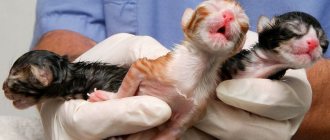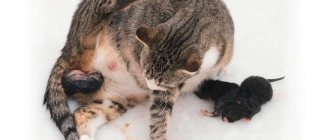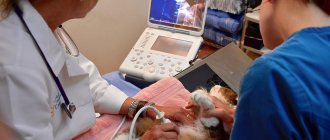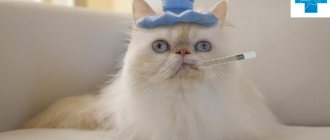- What can an owner do to help a cat during childbirth?
- What to do after giving birth to a cat?
Childbirth in a cat is a natural process that ends pregnancy and involves the fetus leaving the uterus through the cervix and vagina (birth canal).
At what age do cats give birth?
From 7 months, the cat begins to be interested in the opposite sex and becomes sexually mature. If you want to get healthy offspring, veterinarians advise breeding the animal during its second heat.
Cats can give birth until old age, but pet owners should stop their pet’s sex life in time so that the quality of the offspring and the health of the cat are not affected. After all, when abusing a cat’s ability to give birth, people often think only about their own wallet. Thus, to avoid problems, veterinarians recommend spaying or neutering an animal at the age of 6-7 years.
Planning a cat's pregnancy
Pregnancy is a complex process and its planning, including in cats, is a very important stage. But the opinions of experts and ordinary owners on this issue differed:
- Often breeders or felinologists plan pregnancies in their cats no more than once a year. At the same time, they carefully monitor the pet’s health and take a responsible approach to choosing a cat. There is an opinion that with such frequency the female will feel great, which will affect the high quality of the offspring.
- Veterinarians have a different opinion. They believe that if each heat ends in the birth of kittens, this does not negatively affect the health of the cat or offspring. Therefore, pregnancy 3-4 times a year is the norm. Otherwise, if an animal is denied sexual activity, health and mental problems will arise.
- Owners with extensive experience think differently - two lambings every 12 months are enough to maintain the physical tone and well-being of the female, which also will not affect the health of the offspring. With more rare intercourse, the animal begins to suffer both morally and physically.
How to tell if your cat is pregnant
Signs of pregnancy in a cat can be observed 3 weeks after conception. Some people who let their cats go outside can track this period on a calendar (as a rule, the cat does not spend the night at home and does not appear in front of its owners for 3-4 days). Those owners who specifically breed a cat with a cat can also calculate whether the cat is pregnant. We will tell you further how many months you will have to wait for a replenishment. The most difficult thing to predict pregnancy is for those owners whose cat walks outside on its own.
You can determine that a cat is pregnant by the following signs:
- the cat’s appetite has changed: it happens that favorite treats remain untouched, and any food consumption ends in vomiting and severe weakness;
- changes in behavior: the cat sleeps more than before and moves less (if the cat was previously wild and could bite, now it should be affectionate and calm);
- swelling of the mammary glands and redness of the nipples;
- rounding of the abdomen.
Cat pregnancy
Pregnancy in a cat lasts 65-70 days (9-10 weeks, or 2.5 months). If you are unable to independently determine whether pregnancy has occurred and how many months the cat will still bear kittens, seek advice from a specialist.
In the last week before giving birth, the cat begins to choose a place for itself and put its “stuff” there. Owners are advised to think about creating favorable conditions for the animal from the very beginning of pregnancy: choose a spacious box, put diapers or cloth rags on the bottom. The expectant mother should get used to the nest that you built for her.
The duration of pregnancy in cats may vary depending on the number of kittens, the age of the animal and the conditions in which the pet is in the last month of pregnancy. So, if the cat is stressed, then the gestation period may be delayed, and if the pregnancy is multiple, then labor may begin prematurely, in this regard, it is extremely important to know how to understand that a cat is beginning to give birth.
If the due date is postponed a week earlier or a week later, you should not panic, as this is quite natural.
Problems may arise if labor begins earlier than 60 days (the kitten will be born weak and unable to live) or later than 80 days (there is a possibility that the offspring will develop pathologies).
Signs of the beginning of labor in a cat can be determined a day before, or even 1-2 hours before the start of the process.
Contractions and birth of kittens
The process of giving birth to kittens can be divided into two stages:
- The beginning of labor. The uterus begins to contract, the first not too intense muscle contractions appear. At this time, the kittens are preparing to “go out” and line up before passing through the birth canal. At the first stage, it is not always possible to understand that a cat is having contractions. They are invisible and do not cause significant pain, so the animal will not react strongly to them. Contractions will usually recur at intervals of 30-40 minutes. Gradually, the interval will shorten and the duration of the contraction will increase. This period can last 8-10 hours.
- Passage through the birth canal. The grips intensify, the interval between them is reduced to 1 minute. Muscle contractions become distinct and are easy to see with the naked eye. Final contractions are prolonged muscle contractions, also called pushing. They push the kitten through the birth canal. Due to the increase in the intensity of contractions, the fruits begin to come out.
From the onset of the first contractions to the birth of the offspring, it can take about 12 hours. If kittens are not born for a longer period of time, you should seek help from a veterinarian. During prolonged inactive labor, the fetus may experience hypoxia - oxygen starvation, which negatively affects its health and can lead to death.
On average, labor lasts about 24 hours in total. Everything will depend on the number of fruits, the health of the animal, and external factors. Kittens can appear one after another with an interval of 15-30 minutes (sometimes up to 1 hour). During this time, the cat will continue to have contractions with short breaks between attempts. In primiparous cats, contractions may last longer than in animals that have already given birth. However, this statement is not an axiom. Primiparous cats can cope with the birth of their offspring just as successfully as experienced mothers. At the same time, complications are not excluded during the second and third births. This process should always be monitored, since the pet may need help at any time.
The following signs indicate the end of labor:
- no contractions for more than 3 hours;
- the stomach has become soft, the muscles are not tense, the fruits cannot be felt in it;
- The cat behaves calmly and rests.
To know exactly how many kittens should be born, it is recommended to do an ultrasound first.
Stages of pregnancy
Cat pregnancy is usually divided into several stages:
- Stage 1 – the first three weeks of pregnancy. The mammary glands and genitals become swollen, cats begin to sleep more, there is no appetite as such, and activity is zero. The animal requires attention, sleeps with the owner, clinging to him, the animal may have a gag reflex when eating, or an increase in the size of the uterus upon palpation.
- Stage 2 – from the fourth to the sixth week. The kittens begin to become active and move. The expectant mother has a good appetite and gets plenty of rest. A cat may refuse its favorite food and prefer dairy products. If your cat is vomiting, it is best to take it to the vet.
- Stage 3 – six to nine weeks. Kittens move actively, this is best noticeable when the animal is sleeping. The abdomen is large, the mammary glands are enlarged, colostrum may be released. Hair falls out on the cat's belly, internal organs are displaced due to the large size of the kittens. The cat moves carefully, tries not to jump too much, and sleeps on its side. To prevent the pet from gaining excess weight, it is transferred to fractional meals (4-5 times a day).
How does the stomach change during pregnancy?
20 days after conception, the nipples change color. If you have already given birth before, your nipples may change slightly. The belly grows as the kittens grow and develop. But if 1-2 kittens develop and grow in the mother’s belly, then the belly may be small until the last weeks.
Before giving birth, a cat's stomach drops. As a rule, this happens within 7 days, and the stomach takes a pear shape. This is due to the fact that the kittens are already preparing for birth, taking the necessary position for this.
It should also be noted that the expectant mother’s stomach is not soft, but hard, which means that the body is ready for labor and childbirth.
Possible complications
If the kitten is stuck, do not allow the cat to bite through the amniotic sac—breathing in this position could easily cause the newborn to suffocate. Lightly lubricate it with Vaseline, wrap it in gauze and, after waiting for the next contraction, gently pull the body or the skin on the back of the neck, slightly swaying it from side to side. You cannot pull the kitten by the paws: the cub’s limbs are still very weak and may not be able to withstand it. Before pulling, tuck the protruding paw into the birth canal to avoid dislocation.
Even a competent owner who knows how to deliver a cat at home may not be able to cope on his own in case of complications. Urgent assistance from a veterinarian is necessary in the following situations:
- the kitten is stuck in the birth canal and cannot be born;
- contractions continue for more than an hour, and the baby is not born;
- weakness, breathing and heartbeat disturbances, apathy are observed;
- abundant purulent or bloody discharge and an unpleasant odor appeared;
- body temperature is higher or lower than normal (37-39.5 degrees);
- the number of afterbirths differs from the number of cubs born.
Most furry pets have a successful birth, but if something goes wrong, stay cool and don't panic. Try to help the cat by taking it to the clinic in a timely manner or calling a doctor at home.
You can also contact our site's staff veterinarian, who will respond to them as soon as possible in the comment box below.
What to prepare before giving birth to a cat
For comfortable bearing of kittens and their comfortable maintenance in the first weeks after birth, the cat should create all the conditions and prepare a cozy nest. It is best to place this place in silence, away from a noisy room and children, otherwise the cat will look for another place for itself and the kittens.
It is also necessary to organize a spacious maternity area in which the mother and kittens will stay for about two months.
What is not recommended to do before labor begins
To ensure a smooth birth, pay attention to the list of things you should not do:
- irritate the woman in labor with loud screams, numerous guests, parties;
- actively feel the stomach, as you may accidentally injure the cat or kittens;
- Give your cat medications on your own without consulting a specialist;
- ignore vomiting, discharge and changes in the behavior of the pregnant woman;
- allow your cat to come into contact with animals whose health status you do not know;
- allowing you to sleep in a dirty place, handling the animal with dirty hands, frequently changing the linen in the cat’s sleeping area;
- use chemicals to clean the house.
Fertility rate in cats
Felinologists have developed a large number of new breeds of cats, and often, for the sake of one trait, others were abandoned. Pedigree pets rarely give birth to more than 5 kittens, and yard representatives can give birth to 15 cubs. Accordingly, the more pets are born, the greater the likelihood that one of them will continue the family line.
For an approximate calculation of future offspring, professionals recommend paying attention to the number of nipples the expectant mother has. Subtract two from their number and get the approximate number of kittens that should appear. There can be from 6 to 11 mammary glands, but most often there are 8. This method is approximate and often does not work.
What to feed a pregnant cat
A cat preparing for the birth of offspring should be fed high-calorie food enriched with vitamins and minerals.
In the first two weeks of pregnancy, the cat's appetite will increase, so the amount of food should be increased by 10%. The animal must be fed 4 times a day in small portions.
From the 3rd week of pregnancy, the cat's appetite is maximum. It is necessary to increase the volume of food by 50%, but in no case should she be allowed to overeat; she should be fed 5-6 times a day in fractional portions.
A cat's diet should include:
- meat (chicken, beef, turkey);
- egg yolk;
- vegetables (carrots, cabbage);
- dairy products (kefir, cottage cheese, yogurt, sour cream);
- cereals and cereals (buckwheat, rice, wheat);
- a small amount of fish.
If you feed your pet dry food, then choose food for pregnant cats, and then for nursing mothers.
To increase your cat's lactation, give her fresh nettle, but first pour boiling water over the herb so as not to burn the cat's internal organs and mouth.
How to prepare for childbirth
A healthy female can give birth up to 5 times a year, so owners have to be careful to avoid accidental mating.
The question of how to find out when a cat lambs arises after a mating that happened without the knowledge of the owner. The owner needs to show her to the veterinarian to determine the timing of the birth of the offspring. Gestation lasts 9 weeks, preparation of the body begins in 7-10 days. You can find out that an important moment is approaching if you carefully monitor how the cat behaves before giving birth, as its habits change. She becomes restless and tries to hide. A characteristic sign of preparation is nesting syndrome, which is manifested by attempts to arrange a bed in a hard-to-reach place.
Feeding before birth
2-3 days before giving birth, the cat’s appetite worsens, which is considered normal. It is recommended to feed your pet 5-6 times a day in small portions. Remove foods that cause constipation/diarrhea from the diet and give liquid foods: broths, milk. Change the water frequently.
How to arrange a place
The birthing area is prepared in advance so that the pet gets used to it and knows where she will give birth to kittens. Otherwise, she will arrange the bed herself, choosing a secluded place under the sofa, bathroom or in the closet. Then it will be difficult for the owner to help the cat during childbirth.
How to prepare a place for a cat to give birth:
- Find a warm corner away from drafts and noise, where strangers, children, and pets have no access.
- Prepare a spacious box for mother and offspring.
- Cover the bottom with oilcloth, put a mattress on top, then moisture-absorbing diapers (not scented).
- Place bowls for food and water nearby, and a tray with filler not far from the box.
What to prepare from medicines, materials, tools
It is recommended to collect the first aid kit and auxiliary items in advance and keep it next to the box.
To give birth to a cat you will need:
- surgical gloves;
- syringes;
- sharp scissors with rounded ends;
- diapers (soft cotton fabric);
- sterile thread (preferably catgut from a veterinary pharmacy);
- 6-7 pcs. clean cotton towels for drying kittens;
- cotton swabs, sticks;
- pipette;
- sterile syringe with a rubber tip;
- a jar of water for placentas;
- petrolatum;
- alcohol, veterinary antiseptic solution (or brilliant green, hydrogen peroxide, iodine, chlorhexidine);
- antibiotic ointment;
- warmer;
- milk formula for newborn kittens (if the cat refuses to feed).
The following medications will be needed: Oxytocin , Sulfocamphocaine , sodium gluconate. Application and dosage should be agreed with your veterinarian. It is recommended to arrange a consultation or call with him in advance so that he can help the cat give birth at home.
Characteristic signs before childbirth
It is extremely important to know what signs to look out for before your cat gives birth:
- The animal loses its appetite: the cat refuses solid food and eats small amounts of liquid foods (broth, milk, cream, etc.).
- Weakness: The cat spends almost all of her time in the place where she plans to give birth.
- Kittens in the stomach begin to become active: this happens 2 days before birth, as they try to take the correct position for birth. The more kittens there are, the larger they are, the earlier they begin to move and behave more actively.
- The cat often licks its genitals.
- The animal's body temperature decreases, which helps prevent severe bleeding during and after childbirth.
- The nipples swell and milk comes out.
- When labor begins, the cat meows and tries to hide.
- False contractions begin 4-6 hours before birth.
- The waters are receding. This is the main sign of the beginning of labor in a cat. Don't go far, your pet may need your help.
- The cat's plug came out. When will labor begin? A day before giving birth, a white plug comes out as a discharge. The cat may lick it, so watch the animal carefully so as not to miss this moment.
- The cat goes to the toilet often.
- The pet begins to walk with shortness of breath and breathes heavily in its sleep.
Signs that indicate the onset of labor
1–3 days before the onset of labor, you can understand from the cat’s behavior that this moment will soon come:
- The future tailed mother is actively looking for secluded places, every now and then trying to hide in the closet or behind the sofa. Digs there, trying to build a nest. The pet becomes very affectionate, constantly demands attention, and can sometimes be annoying. It rarely happens that a cat, on the contrary, becomes overly aggressive and hides from its owners. Other symptoms:
- at this time, the loop increases greatly, and clear or light pink discharge is observed;
the cat begins to lick itself more often;
- There is a loss of appetite up to complete refusal of food.
- When there are a day or a little less left before lambing, the animal’s body temperature drops to 37°C.
- 4–8 hours before lambing, the animal begins to hunch over. This is how the body reacts to training contractions of the uterus. This process causes great anxiety in the pet; she may complain to the owner, seeking his support. But another option is also possible - she will try to hide.
- 4 hours before labor, the mucus plug comes off. It is a small transparent clot, sometimes it can have a yellowish or greenish tint and include small inclusions of brown, which is considered normal. Often the plug comes out during urination or in parts. But this moment may not be noticed in an overly clean animal.
- When the temperature rises to normal—38–39°C—this means that there are about 2 hours left before birth.
1–3 days before giving birth, the cat persistently demands attention and affection
If a cat experiences premature lambing, then the described symptoms occur almost 2 times faster.
Call a veterinarian immediately if:
- a furry pet carries kittens longer than expected;
- the pet experiences fever, vomiting and convulsions;
- bleeding lasts more than 10 minutes and is accompanied by an unpleasant odor.
Video: signs of the beginning of lambing
Premature birth
Sexual infections, physical trauma, and severe stress are some of the main causes of premature lambing. This problem can occur in older cats or in representatives of breeding and selective breeds who are giving birth for the first time.
Be sure to show your pregnant cat to a veterinarian, and before giving birth, agree with him about help if necessary.
If lambing occurs when the gestation period is 51 days or more, the kittens are considered viable and must be fought for their lives. Call your veterinarian immediately. But under no circumstances try to stop contractions in order to postpone labor until a specialist arrives. You will have to deliver the baby yourself.
If the premature birth was successful and the cat feels fine, still show her to a specialist.
How to behave with a pet
If this is your first time attending the birth of a family pet, then excitement is a natural process. You must understand that when a furry mother goes into labor, she experiences pain, fear and needs support. Your behavior will largely determine the successful outcome of the case. Even if you don’t really understand how to act, control yourself. Get together and provide all possible assistance:
- Try to ensure that no strangers or curious people gather near the lambing area.
- Apart from the owner, there should be no other people in the cat's field of vision, even if they are family members to whom the cat is accustomed.
- Talk kindly to your pet, show her that you are nearby and will not abandon her in difficult times. Stroke it from top to bottom. Speak kind words.
Your participation will calm the cat before giving birth
How to tell if your cat is going into labor
Throughout pregnancy, the cat behaves in the same way as all animals of its species: it eats excellently and sleeps a lot.
Usually, the question “how to understand that a cat is going into labor” does not arise for owners, since everything becomes obvious from the changing behavior of the animal. When the day of birth arrives, the cat shows the first signs that signal the animal’s readiness to give birth - a symptom of the first contractions: the cat screams unnaturally, refuses to eat, walks from corner to corner, looks into the owner’s eyes. The cat looks tired, constantly licks its genitals, and “points” to its stomach, as if it wants to say that it needs help.
Complications and how to help?
The cat's behavior after giving birth indicates its general well-being.
If the female is engaged in licking the emerging offspring, then there is no need to rush to the doctor.
If the pet has lambed, feeds and licks the kittens, then she can be taken to the veterinarian within 2-3 days. Otherwise, you should immediately consult a doctor. The veterinarian will give advice and prescribe treatment for the cat. Ignoring the fact that a cat breathes quickly and intermittently, eats poorly and strains has a serious impact on its health. Veterinarians name cases when a woman in labor died due to the irresponsibility of the owner.
During childbirth
Obstetrics of first-time cats requires careful monitoring by a doctor. Multiparous women have experience and the animal tolerates contractions more easily. During a home birth, you should prepare for possible difficulties:
- A common occurrence is that the afterbirth does not come out. To prevent it, it is necessary to control their intake.
- You should intervene when two kittens climb at once. It is recommended to carefully adjust the amniotic sacs and push them towards the exit of the baby. At the same time, the second one “rolls” along the fallopian tubes and gradually comes out.
- If the babies died during labor, and the bladder is sticking out from the cat, you should immediately remove it. All movements become soft, guaranteeing maximum care.
- The amniotic space without kittens inside does not pose a health hazard. If she wants, the woman in labor can eat the contents between contractions. Vitamins will help the animal prepare for the birth of the baby, and their smell will provoke acceptance of children.
- If contractions started, but stopped after some time. In this case, induce labor in the cat using medication. Your veterinarian will tell you what the medications are called.
- The attempts last for more than 26 hours, and not a single kitten appears - a dangerous symptom. The likely cause is false contractions, the large size of the babies, or incorrect position of the amniotic sac.
After childbirth
Sometimes it happens that a pet does not perceive her babies, which is why they may not survive.
Severe complications plague the animal during delivery and after the birth of kittens. Possible problems with the body may include:
- Difficulty breathing caused by the release of hormones.
- After giving birth, a cat does not eat for the first 1-2 days. Lack of appetite in the immediate hours after delivery is not dangerous. If the cat has lost a lot of weight after giving birth, constantly meows and refuses to eat, you should show your pet to a veterinarian. The reason may be pain and health problems.
- Aggression towards cubs is more common in first-time mothers. This is a purely psychological problem (especially typical for British mothers), which leads to the death of kittens due to the lack of maternal warmth and milk. The owner helps with treatment and a special regime. The veterinarian determines how to treat.
- The cat limps after giving birth due to pain. It should be treated by a doctor with painkillers.
Childbirth
How does labor begin in a cat?
- The cat lies on its side.
- Begins to arch his back.
- Push (strain your stomach). If you put your palm on your stomach, you can feel it.
- Meows loudly as the strength of the contractions increases.
- Passage through the genital tract: the cat strains, the muscles of the abdomen and thighs contract. After 4-5 attempts, the kitten appears.
- The kitten comes out in the amniotic sac or without a sac.
- Stimulation of breathing: the cat bursts the bladder, licks the kitten, and clears the airways of fluid.
- Rupture of the umbilical cord. The cat chews the umbilical cord and eats the afterbirth. Be sure to check that there are as many afterbirths as there are kittens.
- Lactation: Immediately after birth, the kitten attaches itself to the mother's nipple.
Induction of labor
If the due date has come, the cat’s body temperature has dropped to 37°C, more than two days have passed, then you need to know how to induce labor in a cat. First, they try simple remedies: massage the tummy and nipples: this will cause the production of oxytocin, and it will start the process of contractions. It is dangerous to administer oxytocin on your own - physiological unpreparedness for lambing can lead to cervical rupture.
If two days have already passed, signs of labor are evident, but the process has not started, then contact a veterinarian.
Helping a cat give birth
The animal needs care and support at the time of birth. Therefore, the owner is required to:
- calm your pet throughout the entire process;
- sit near the place where the cat will give birth;
- bring a supply of water so that the cat does not walk around the room again, because she will want to drink in any case (it is necessary to regularly offer the animal to drink warm milk or water at room temperature to avoid dehydration);
- isolating the room where the lambing takes place from other pets and children; it is best to remain alone with the woman in labor - this will make both her and you feel calmer;
- do not forget to ventilate the premises, but without creating a draft;
- Call the veterinarian if complications arise or there are fears that something will go wrong, or if you are not confident in your abilities and are afraid that you will not be able to help your pet
It is impossible to ignore the first signs of labor in a cat, despite the strong opinion that a cat can give birth without any problems without human help.
How to give birth correctly
- A few hours before giving birth, the cat will begin to behave restlessly: rush from side to side, get nervous, meow loudly, dig around in the box, refuse food. During this period, many animals try to stay close to their owners, as if seeking their support. At this stage, your task is to caress the pet and calm it down.
- The first sign that labor has begun is contractions, during which the cat will breathe with its mouth open. She can give birth in a sitting position (crouching on her hind legs) or lying on her side. During the normal course of labor, the kitten is born within an hour after the start of contractions.
- Kittens can be born in intervals of 10 minutes to 2 hours. If a pet cannot give birth to another baby for a long time, consultation and assistance from a veterinarian is necessary.
- Throughout the entire process, remain calm: as a rule, animals sense the mood of their owners. Do not interfere in the process unless unnecessary; it is better to calm your pet with a gentle voice and lightly stroke it.
- If the contractions are weak, you can help her: stroke your pet’s belly and back with smooth movements.
- Usually, after the birth of a kitten, the cat itself bites through the amniotic sac and gnaws the umbilical cord. But in the case of the first birth, she may not pay any attention to the newborn, taking care of herself. In this case, you need to intervene. Carefully break the bubble and release the kitten. Then remove mucus from the lungs using a clean pipette; You can also turn the kitten upside down, grabbing it by the body and head, and shake it very gently to allow the liquid to flow out. When the newborn begins to breathe, cut the umbilical cord with antiseptic-treated scissors at a distance of 2-5 centimeters from the abdomen and tie it with thread. The tip also needs to be processed.
- Wipe the kitten with clean gauze and place it on the cat's belly so that it can suck milk - this will not only allow the newborn to get enough, but will also stimulate the further process of childbirth in its mother.
- Kittens that have already eaten and been licked should be placed in a separate soft nest with a heating pad, where they will sleep. Dry all babies dry with a clean diaper first.
- Count the number of placenta appearing behind each newborn. As a rule, cats eat them, but it is better to allow your pet to eat no more than one or two - otherwise she may have an upset stomach.
Note! If there are fewer afterbirths than kittens, be sure to consult a veterinarian - the placenta remaining in the uterus can cause inflammation.
- The end of labor is usually noticeable by the behavior of the female: she calms down and begins to peacefully feed the newborns. You can also gently feel her belly to determine if there are any kittens left there.
- Put away soiled diapers, tidy up the box and provide complete peace for mother and babies. Do not allow other pets near them, including the father of the kittens, if he lives with you - the cat can harm the newborns and even eat them. Place a bowl of water, a tray and food for the mother cat near the nest.
How to deliver a cat?
Childbirth in cats can be of three levels of complexity:
- Lungs: the cat does not require much human attention and care; it mostly copes on its own. But the owner must observe and control the process so that the cat does not crush her kitten so that the afterbirth comes out. It takes her less than one hour to give birth to a kitten. The cat's discharge the day after birth should not contain mucus, pus, or blood.
- Moderate: at the birth of kittens, the cat has complications that the owner can help cope with, without the help of veterinarians. Lightly stroking the abdomen from the sides to the uterus may help. If the mother does not want to gnaw the umbilical cord, then it is necessary to cut it using disinfected scissors (a few centimeters should remain to the navel), and then treat the incision site with iodine. If the kitten was born in the amniotic sac and the mother is in no hurry to tear it apart, you need to do this yourself so that the baby does not suffocate. To do this, use clean, disinfected hands to tear the film and wipe the baby dry. If the kitten is not breathing, you need to turn it head down and, holding it with both hands, shake it to remove water from the respiratory tract.
- Severe: in this case, you must call a qualified specialist for help. If the cat cannot lamb for more than 5 hours, you can give a Gamavit injection (0.5 cc), which will intensify contractions. If after an hour the medicine does not work, then an injection of Oxytocin (0.5 cc) should be administered. When doing this, you need to massage the belly towards the uterus. To make sure that your cat can be given this medicine, you should consult your veterinarian. The health of your pet depends on you. If the woman in labor can barely move, then sodium gluconate should be administered. The volume of the drug administered depends on the weight of the cat.
Giving birth to a cat at home
A responsible owner should know how to give birth to a beloved cat . First, prepare everything you need:
- a house that the cat will examine and “accept” in advance;
- towels or absorbent diapers;
- clean cloths or gauze;
- thick silk thread;
- scissors with rounded ends;
- alcohol for disinfecting scissors;
- hydrogen peroxide;
- streptocide in powder form;
- a pipette or syringe that can be used to suck out liquid from the baby’s nose;
- afterbirth bowl;
- warmer.
Easy birth
A cat's birth is considered easy when there is no need for human intervention. It will be enough to simply be close to the woman in labor. The main thing you need to take care of is that the mother should not accidentally crush her offspring. It is also important to monitor whether each afterbirth has come out. If suddenly some placenta is missing, then the cat’s discharge is observed for several more hours; the process may take a little longer.
An easy birth is not characterized by pus, mucus and blood.
Middle birth
Sometimes some complications arise during home birth. If the process is delayed, you need to stroke the cat from the side of the neck to the uterus.
If the cat is distracted and does not chew the umbilical cord, a person does this, treating the cut site with iodine. The newborn may not breathe: minor resuscitation will be required. The respiratory tract is cleared of mucus using a pipette or suction, and the oral cavity is examined. Anything that should not be there is removed with a rubber bulb. If breathing does not appear, the baby is picked up and carefully folded in half - several times in a row. You can also rub the baby with a rough towel and gently shake it upside down.
Difficult birth
global $ads_google;
//data-ad-slot=”2475549904″ $ads_google = empty($ads_google) ? false : true; ?> if ($ads_google == false) {?> $ads_google = true; ?> } ?> Childbirth turns out to be difficult when, despite everything, the kitten is not born on its own: the baby gets stuck in the birth canal, or two babies try to be born at the same time. Before calling the veterinarian and hoping for a caesarean section, there are a number of independent steps to take.
You need to understand that it is better to act and help the cat during childbirth than to later regret the misfortune that happened.
If labor stops or its result is zero, the cat can be taken for an ultrasound or x-ray. It may turn out that the kitten has died, or it is extremely large and has blocked the exit.
Sometimes it is necessary to turn the kitten over: a gloved index finger, lubricated with Vaseline, is inserted into the vagina. You need to carefully push the baby back and try to turn him over. If it is simply stuck, then it is picked up under the hanger and carefully pulled out with attempts.
Unpleasant consequences after childbirth
Unfortunately, childbirth does not always go smoothly; various unpleasant consequences can occur. So, the first thing you need to pay attention to after childbirth is discharge. Any colored, unpleasant-smelling discharge is a deviation from the norm. If a cat has intense pink discharge, this is a sign of a fungal disease of the genital organs. If they are green, there is a bacterial infection. If the discharge is black-green with a strong unpleasant odor, it means rotting. If they are cloudy yellow or yellow-green, there is purulent inflammation in the womb.
Watery discharge is possible, which may be caused by blood accumulation in the uterus, uterine rupture, or rupture of sutures (during caesarean section).
If after birth the bleeding does not stop for 15 minutes, you should urgently take your pet to the veterinarian and provide qualified assistance.
Another problem after childbirth may be the lack of milk. The reason may be the stress of the mother in labor, so you should create comfort and ensure peace of mind for the mother, feed her well and let her drink milk.
It often happens that after giving birth a cat is left with a hanging belly. The reason may be that there is a dead kitten in the stomach. You need to carefully feel the cat's belly and take the animal to the veterinarian.
After giving birth, it is best to feed a cat with easily digestible food, milk with the addition of fish oil and calcium. Water supplies must be constantly replenished.
The beginning of labor, what you can do to help, how to take it
The onset of contractions is indicated by rhythmic contractions of the cat's abdominal muscles. The higher their frequency, the closer the birth of babies. You can help your cat at this stage with light massage movements in the abdomen and back. This will reduce muscle tension and speed up the process.
With a normal birth, the cat copes with all tasks independently. Some cats do not even tolerate close attention during this important period. Others, on the contrary, want to share all the joys and hardships of motherhood with their owner.
If the kitten, for some reason, is stuck and cannot be born, you need to lubricate your fingers with Vaseline and carefully pull the baby out.
Under no circumstances should you pull the kitten by the head or paw. You need to grab the area behind the head.
Most often, weakness of labor occurs in older mothers, as well as in British cats who are overweight.
If the cat has not chewed the umbilical cord, you should twist the umbilical cord in the form of a flagellum, then moisten the thread in an antiseptic and use it to crush the umbilical cord at a distance of 2 - 3 cm from the baby’s tummy. Cut the umbilical cord with sterile scissors.
If issues that cannot be resolved at home arise - bleeding, a prolonged labor process, prolonged ineffective contractions, shortness of breath in a cat - you should urgently consult a veterinarian.
British cat giving birth
British cats cannot cope with childbirth on their own, so all responsibility lies on your shoulders. Therefore, it is so important to thoroughly understand the question of how labor begins in a British cat.
If the due date is approaching, you need to carefully monitor when the plug (a white-pink clot) comes out.
During pregnancy, it is better to exclude seafood from your pet’s diet, because they destroy vitamin B, which is necessary for kittens.
As a rule, cats who give birth for the first time may experience complications, so you need to prepare in advance:
- diapers that will need to be changed when dirty;
- antiseptic;
- sterilized scissors;
- sterile disposable gloves;
- cotton pads;
- Vaseline oil;
- syringes for 2 and 5 ml;
- calcium gluconate (to stimulate labor).











